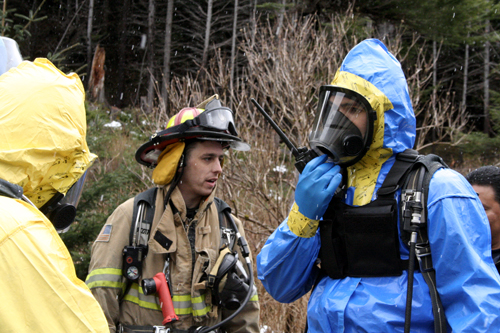
Travis Miller (left) and Joe Danon (right) are with the Sitka Fire Dept. They were among the first on the scene and took photos of inside the shed, where the meth lab was housed. When the U.S. Coast Guard arrived, the team looked at the photos before deciding on a plan. (Photo by Anne Brice/KCAW)
Sitkans successfully survived a terrorist bombing earlier this week, and didn’t lose a minute’s sleep over it. They also dealt with a suspected poisoning of the food supply, a hospital patient with a gun, and a dangerous meth lab. All these scenarios – though realistic – were not real. They were created by an organization whose job is to test the resources of communities to deal with real-world threats. Here’s the story about one of Sitka’s largest-ever emergency response drills.
On Tuesday morning, a mysterious bag was left at the airport in Sitka.
Al Stevens is the assistant fire chief at the Sitka fire department. “And what had happened was one of the Alaska Airlines employees kicked the bag and it exploded,” he said.
“Did it really explode?” I asked.
“Well, it did,” said Stevens. “There was an alarm in there and like, powder stuff.”
So the airport staff evacuated the building and called the police. After the police arrived however, the employees were told it was only a drill.
Sitka hosted an emergency preparedness simulation that has been a year in the making. “The scenario is that this radical group came into Sitka,” said Stevens. “They were really against the wild salmon aquaculture. They wanted to do farm fishing. So they wanted to dispose of the farm fishing. They wanted to really disrupt things around Sitka.”
Although there was no real threat in the drill, Stevens wants to be clear that every situation in the drill was as real as possible.

Carin Farley (left) is a ranger with the National Park Service, and Ismael Godoy (right) is a civilian contractor for the U.S. Dept. of Defense (DOD) from Hawaii. Godoy says DOD conducts all the training and readiness exercises for the civil support team and weapons of mass destruction in the whole Pacific region. (Photo by Anne Brice/KCAW)
“What if you just simulated it and everyone just lollygagged around?” he asked. “And said, okay, this is meth…what is the difference if you actually walked into the scene and woof, you actually smelled the ammonia?”
The people in charge of creating these so-called threats is the Emergency Response Training Institute (ERTI), a Seattle organization that puts on training drills.
“The grow things, make things,” said Stevens. “They’re the ones who put together all this real stuff. So, they’re replicating what the bad people would do. They’re the bad people.”

The Hazardous Materials Division of the U.S. Coast Guard, known as HAZMAT, came onto the scene after fire officials reported a possible meth lab in the shed. (Photo by Anne Brice/KCAW)
For the drill in Sitka, ERTI created a list of scenarios. Early morning explosions, planted bags with fake bombs, poisoned food, a hospital patient with a weapon, a 17-person crew stranded on an island – scenarios that challenged the fire hall to involve all of Sitka’s resources, and the resources of organizations from around the region who flew in to participate in the drill.
“We can’t just do it by ourselves. We have state parks, Sitka trail works, Allen marine, forest service, national weather service, tsa, lapc, us coast guard, raven radio, public health, dept of homeland security.”
As we talk, Stevens gets a radio call about a meth lab in town. It’s out Sawmill Creek Road at an abandoned shack. A fire crew has discovered a chemical lab in a shed. Police drive over to check out the scene.
The firefighters are suited up in full-body gear and masks covering their faces. They took some photos of the inside of the shed to show police.

The so-called “abandoned shed” housing a meth lab turned out to be on Assistant Fire Chief Al Stevens’ property. (Photo by Anne Brice/KCAW)
Police now have to secure a warrant, so they can search and seize evidence. After it’s tested and the substance is determined, they’ll evacuate the area depending on what they find.
And now, everyone waits. It will take hours – the rest of the day – to deal with the issue. Actual problems take time to handle.
“What if this really happened?” asked Stevens. “What are the chances of this happening in Sitka? Slim to none. But this is unfortunately the world we live in now. This is not just a response for Sitka, it’s role playing for responses anywhere.”
And he says, it only cost the city about $200. The Dept. of Homeland Security footed most of the bill, along with the state of Alaska.































